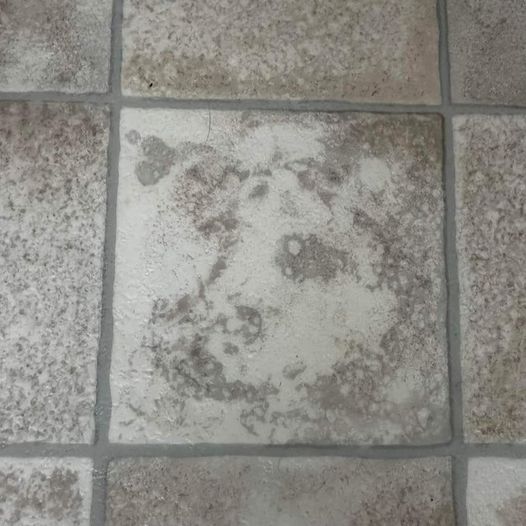In the fields of psychology and visual perception, there’s an intriguing phenomenon where people see familiar patterns—most often faces—in random textures or objects. This phenomenon, called pareidolia, is well illustrated in the image above. At first, it appears to be just a regular tile floor. But with a closer look, something more intriguing appears—a faint face hidden in the tile.

What is Pareidolia?
Pareidolia is when the brain interprets random stimuli—whether shapes, patterns, or sounds—as something meaningful, often resembling a face or figure. This explains why you might see animals in clouds, faces in rocks, or, in this case, a human-like image on a worn tile floor.
Our brains are naturally wired to recognize faces, an evolutionary trait that helped early humans identify friends, enemies, and potential threats from a distance. This facial recognition ability is so ingrained that even when the resemblance is vague, our brains fill in the gaps, leading us to see faces in places where none actually exist.
The Face in the Tile: A Detailed Look
In the image, the rough texture of the tile outlines a face, complete with “eyes,” a “nose,” and a “mouth.” The eyes might appear as darker spots, the nose as a central smudge, and the mouth as a faint curve. The result is a ghostly face, like a hidden character lurking in the background, just waiting to be noticed.
This example of pareidolia transforms an ordinary floor tile into something mysterious, artistic, and even a bit eerie. For some viewers, it can evoke a sense of wonder, while for others, it may seem unsettling, as if the inanimate world around us has come to life. This transformation adds a sense of mystery and beauty to an otherwise mundane object, inviting the observer to see the world from a new perspective.
@zoebreadtok i will regret this design. it takes a very long time. #pareidolia #faces #people ♬ Minor Swing – Swing of France
Why Do We See Faces in Objects?
Seeing faces in inanimate objects is surprisingly common and not limited to tiles or wall patterns. This behavior is linked to our evolutionary need for social interaction and survival. Recognizing faces quickly was crucial for early humans, as it helped them distinguish allies from enemies and navigate complex social environments. Over time, our brains became adept at picking up even the slightest hints of facial cues—sometimes to the point of over-interpretation.
Researchers believe that this tendency to spot faces has played a role in our ability to read emotions, understand social dynamics, and even create art. It shows our brain’s remarkable capacity to find meaning in the world, even when that meaning is purely imagined.
The Artistic Side of Pareidolia
Pareidolia isn’t just a scientific phenomenon—it has inspired artists for centuries. Artists often find hidden images in the world around them, using pareidolia as a source of creative inspiration. This art form encourages viewers to look beyond the obvious, finding beauty and meaning in unexpected places.
The face in the tile can be seen as a form of natural art—an accidental masterpiece shaped by time, wear, and imagination. It’s a reminder that art doesn’t always require intention; sometimes, it emerges from the simplest and most mundane things, if we take a moment to observe.
Pareidolia also underscores the subjective nature of art. What one person sees as random patterns, another might interpret as a hidden image. This diversity of interpretation is part of what makes pareidolia so fascinating, allowing us to see the world with a more imaginative eye.
Finding Magic in the Mundane
Pareidolia is more than just a quirky mind trick—it’s a way for our brains to find familiarity and wonder in everyday objects. It turns ordinary moments into playful experiences, whether it’s seeing a face in a tree trunk, a creature in the clouds, or a figure formed by shadows. It encourages us to look at the world with a sense of curiosity and imagination.
This ability to find faces in random places also adds a touch of whimsy to our daily lives, reminding us that perception is often shaped by creativity and interpretation. It reveals how we seek meaning and joy in our surroundings, transforming the mundane into magical moments.
Conclusion
The next time you’re walking across a tile floor, gazing at a cloudy sky, or staring at a textured wall, pause for a moment and look closer. You might just spot a face peeking back at you. Pareidolia shows how our brains interpret the world, finding beauty and meaning in the ordinary. Whether it’s a faint face on a tile or a mysterious figure in the shadows, these moments of recognition remind us that magic can be found in everyday life—if only we take the time to notice.





